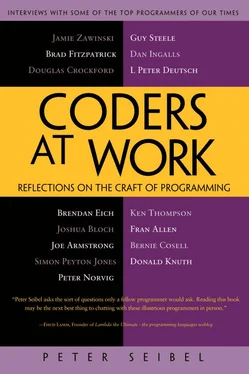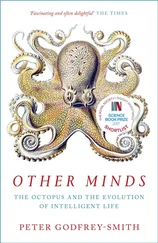Peter Seibel - Coders at Work - Reflections on the craft of programming
Здесь есть возможность читать онлайн «Peter Seibel - Coders at Work - Reflections on the craft of programming» весь текст электронной книги совершенно бесплатно (целиком полную версию без сокращений). В некоторых случаях можно слушать аудио, скачать через торрент в формате fb2 и присутствует краткое содержание. Жанр: Программирование, на английском языке. Описание произведения, (предисловие) а так же отзывы посетителей доступны на портале библиотеки ЛибКат.
- Название:Coders at Work: Reflections on the craft of programming
- Автор:
- Жанр:
- Год:неизвестен
- ISBN:нет данных
- Рейтинг книги:3 / 5. Голосов: 1
-
Избранное:Добавить в избранное
- Отзывы:
-
Ваша оценка:
- 60
- 1
- 2
- 3
- 4
- 5
Coders at Work: Reflections on the craft of programming: краткое содержание, описание и аннотация
Предлагаем к чтению аннотацию, описание, краткое содержание или предисловие (зависит от того, что написал сам автор книги «Coders at Work: Reflections on the craft of programming»). Если вы не нашли необходимую информацию о книге — напишите в комментариях, мы постараемся отыскать её.
Coders at Work
Founders at Work
Coders at Work: Reflections on the craft of programming — читать онлайн бесплатно полную книгу (весь текст) целиком
Ниже представлен текст книги, разбитый по страницам. Система сохранения места последней прочитанной страницы, позволяет с удобством читать онлайн бесплатно книгу «Coders at Work: Reflections on the craft of programming», без необходимости каждый раз заново искать на чём Вы остановились. Поставьте закладку, и сможете в любой момент перейти на страницу, на которой закончили чтение.
Интервал:
Закладка:
Seibel:Do you refactor to keep the internal structure of the code coherent? Or do you just have a very good sense at the beginning how it’s all going to fit together?
Zawinski:I usually have a pretty good sense of that. I don’t remember too many occasions where I thought, “Oh, I did this whole thing inside out. I’m going to have to move everything around.” That does happen sometimes.
When I’m just writing the first version of the program, I tend to put everything in one file. And then I start seeing structure in that file. Like there’s this block of things that are pretty similar. That’s a thousand lines now, so why don’t I move that into another file. And the API sort of builds up organically that way. The design process is definitely an ongoing thing; you never know what the design is until the program is done. So I prefer to get my feet wet as early as possible; get something on the screen so I can look at it sideways.
Also, once you start writing the code, you’re gonna realize, “No, that was a dumb idea. Why did I think that this module was going to be really easy when actually it’s way more complicated than I thought?”
Which is something you’re not going to clue into until you actually start writing code and you feel it getting away from you.
Seibel:What are the signs that something is getting away from you?
Zawinski:When you go into something and you have in your head, “Oh, this is going to take me half a day and it’s gonna be a chunk of code this size,” and then you start doing it and you get that sinking feeling like, “Oh, right, I need this other piece too; well, I’d better go off and do that. Oh, and that’s kind of a big problem.”
Seibel:I’ve noticed that one thing that separates good programmers from bad programmers is that good programmers are more facile at jumping between layers of abstraction—they can keep the layers distinct while making changes and choose the right layer to make changes in.
Zawinski:There’s definitely got to be some style in where you decide to put things—it can matter a lot down the line. Being able to just hack it out somewhere up near the user versus making a maybe larger change that may have repercussions down at the bottom—either of those can be the right answer and it is tricky to know which is which.
This change I need to make, is it really one little special case or are there eventually going to be 12 of these? I think one of the most important things, for me anyway, when building something from the ground up like that is, as quickly as possible, getting the program to a state that you, the programmer, can use it. Even a little bit. Because that tells you where to go next in a really visceral way. Once the thing’s on the screen and you’ve got the one button hooked up that does one thing, now you kind of know, which button is next. Obviously that’s a GUI-centric description of what I’m talking about.
Seibel:We talked a bit about some of the really hideous bugs you had to track down like that thing with GDB. But let’s talk a little bit more about debugging. For starters, what’s your preferred debugging tool? Print statements? Symbolic debuggers? Formal proofs of correctness?
Zawinski:That’s changed over the years a lot. When I was using the Lisp machines it was all about running the program and stopping it and exploring the data—there was an inspector tool that let you browse through memory and I changed it so basically the Lisp listener became an inspector. So anytime it printed out an object there was a context menu on it so you could click on this thing here and have that value returned. Just to make it easier to follow around chains of objects and that sort of thing. So early on that was how I thought about things. Getting down in the middle of the code and chasing it around and experimenting.
Then when I started writing C and using GDB inside of Emacs I kind of tried to keep up that same way of doing things. That was the model we built Energize around. And that just never seemed like it worked very well. And as time went by I gradually stopped even trying to use tools like that and just stick in print statements and run the thing again. Repeat until done. Especially when you get to more and more primitive environments like JavaScript and Perl and stuff like that, it’s the only choice you have—there aren’t any debuggers.
People these days seem confused about the notion of what a debugger is. “Oh, why would you need that? What does it do—put print statements in for you? I don’t understand. What are these strange words you use?” Mostly these days it’s print statements.
Seibel:How much of that was due to the differences between Lisp and C, as opposed to the tools—one difference is that in Lisp you can test small parts—you can call a small function you’re not sure is working right and then put a break in the middle of it and then inspect what’s going on. Whereas C it’s like, run the whole program in all of its complex glory and put a break point somewhere.
Zawinski:Lisp-like languages lend themselves more to that than C. Perl and Python and languages like that have a little more of the Lisp nature in that way but I still don’t see people doing it that way very much.
Seibel:But GDB does give you the ability to inspect stuff. What about it makes it not usable for you?
Zawinski:I always found it unpleasant. Part of it is just intrinsic to being C. Poking around in an array and now I’m looking at a bunch of numbers and now I have to go in there and cast the thing to whatever it really is. It just never managed that right, the way a better language would.
Seibel:Whereas in Lisp, if you’re looking at a Lisp array, they’ll just be printed as those things because it knows what they are.
Zawinski:Exactly. It always just seemed in GDB like bouncing up and down, the stack things would just get messed up. You’d go up the stack and things have changed out from under you and often that’s because GDB is malfunctioning in some way. Or, oh well, it was expecting this register to be here and you’re in a different stack frame, so that doesn’t count anymore.
It just always felt like I couldn’t really trust what the debugger was actually telling me. It would print something and, look, there’s a number. Is that true or not? I don’t know. And a lot of times you’d end up with no debug info. So you’re in a stack frame and it looks like it has no arguments and then I’d spend ten minutes trying to remember the register that argument zero goes in is. Then give up, relink and put in a print statement.
It seemed like as time went by the debugging facilities just kept getting worse and worse. But on the other hand now people are finally realizing that manual memory allocation is not the way to go; it kind of doesn’t matter as much any more because the sorts of really complicated bugs where you’d have to dig deep into data structures don’t really happen as often because those, often, in C anyway, were memory-corruption issues.
Seibel:Do you use assertions or other more or less formal ways of documenting or actually checking invariants?
Zawinski:We went back and forth about what to do about assertions in the Netscape code base. Obviously putting in assert statements is always a good idea for debugging and like you said, for documentation purposes. It expressed the intent. We did that a lot.
But then the question is, well, what happens when the assertion fails and you’re in production code; what do you do? And we sort of decided that what you do is return zero and hope it keeps going. Because having the browser go down is really bad—it’s worse than returning to the idle loop and maybe having leaked a bunch of memory or something. That’s going to upset people less than the alternative.
Читать дальшеИнтервал:
Закладка:
Похожие книги на «Coders at Work: Reflections on the craft of programming»
Представляем Вашему вниманию похожие книги на «Coders at Work: Reflections on the craft of programming» списком для выбора. Мы отобрали схожую по названию и смыслу литературу в надежде предоставить читателям больше вариантов отыскать новые, интересные, ещё непрочитанные произведения.
Обсуждение, отзывы о книге «Coders at Work: Reflections on the craft of programming» и просто собственные мнения читателей. Оставьте ваши комментарии, напишите, что Вы думаете о произведении, его смысле или главных героях. Укажите что конкретно понравилось, а что нет, и почему Вы так считаете.












